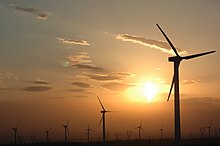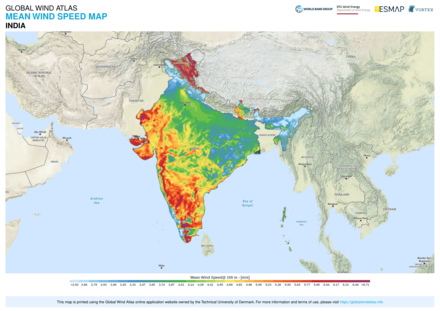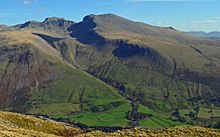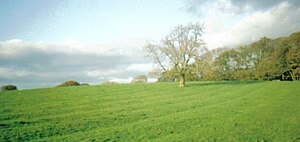For solar power, South Asia has the ideal combination of both high solar insolation and a high density of potential customers.
Cheap solar can bring electricity to a major chunk of subcontinent's people who still live off-grid, bypassing the need of installation of expensive grid lines. Also since the costs of energy consumed for temperature control squarely influences a regions energy intensity, and with cooling load requirements roughly in phase with the sun's intensity, cooling from intense solar radiation could make perfect energy-economic sense in the subcontinent.
Cheap solar can bring electricity to a major chunk of subcontinent's people who still live off-grid, bypassing the need of installation of expensive grid lines. Also since the costs of energy consumed for temperature control squarely influences a regions energy intensity, and with cooling load requirements roughly in phase with the sun's intensity, cooling from intense solar radiation could make perfect energy-economic sense in the subcontinent.
Renewable energy by country
Bangladesh
In Bangladesh,
biomass, hydro and solar are the main sources of renewable energy and
altogether these sources contribute about 60% of the nation's primary
energy supply.
A number of domestic solar energy systems are in use in houses around
the country. The use of solar energy on this scale is highly potential
and advantageous as more than 60% of areas in the country do not have
access to main grid electricity. The World Bank
is backing a program of making solar energy available to wider
population in Bangladesh, as part of the Rural Electrification and
Renewable Energy Development Project (REREDP), which subsidizes solar
energy systems.
A typical 'solar home system' can power two to eight 'low energy'
lights, plus a socket for TV, radio or battery recharging, and a mobile telephone charging unit, too. Each system consists of a solar photovoltaic panel,
mounted on the house roof. Depending on its size, this provides between
40W and 135W of electricity in full sunlight (the most common being
50W).
Grameen Shakti
is the largest organization installing rural based solar home system
(SHS) in Bangladesh. Other companies working on similar solar energy
based SHS are Rural Services Foundation (RSF), Brac,
Hilfulfujal and so on. The model of micro finance based SHS is now
being copied in other parts of the world as a successful business model.
Rahimafrooz
is a major supplier of high quality solar batteries and other solar
components for the program. Rahimafrooz Renewable Energy Ltd (RRE) has
been the pioneer in installing solar powered centralized systems, water
pumps for irrigation and pure drinking water, water heaters, street
lights, and solar-powered telecom solutions to various organizations.
They are working closely with pertinent government organizations in
installing solar powered medical refrigerator that provides emergency
live saving medicines in the off-grid rural areas.
A company named Digital Technology is doing research and
development of solar PV products like solar billboard lighting, mini
grid system for irrigation etc.
China
Rooftop solar water heaters are ubiquitous in modern China
In China there now are six factories producing at least 2 GW/year each of monocrystalline, poly-crystalline and non-crystalline Photovoltaic cells. These factories include the LDK Solar Co, Wuxi Suntech Solar Energy Co., Ltd., which produces approximately 50 MW/year of solar cells and photovoltaic modules;
the Yunnan Semi-conductor Parts Plant, which manufactures approximately
2 MW/year of mono-crystalline cells; the Baoding Yingli Solar Energy
Modules Plant, which manufactures approximately 6 MW/year of
polycrystalline cells and modules; the Shanghai Jiaoda Guofei Solar
Energy Battery Factory, which produces approximately 1 MW/year of
modules; and the Shanghai PV Science and Technology Co., Ltd., which
produces approximately 5 MW/year of modules.
China has become a world leader in the manufacture of solar
photovoltaic technology, with its six biggest solar companies having a
combined value of over $15 billion. Around 820 megawatts of solar PV
were produced in China in 2007, second only to Japan. Suntech Power Holdings Co based in Jiangsu, is the world's third- biggest supplier of solar cells.
There are some obstacles to the further development of the
Chinese solar energy sector that China faces. These obstacles include
the lack of a nationwide comprehensive photovoltaic
(PV) plan, the lack of updated facilities and sufficient financial
resources to support PV research at research institutes, the lack of
sufficient facilities and resources at companies manufacturing PV
products, the failure of companies to be able to produce high quality,
reliable and low cost PV products and the relatively weak educational
and training opportunities in China for PV science and technology.
About 50 MW of installed solar capacity was added in 2008, more
than double the 20 MW in 2007, but still a relatively small amount.
According to some studies, the demand in China for new solar modules
could be as high as 232 MW each year from now on until 2012. The
government has announced plans to expand the installed capacity to 1,800
MW by 2020. If Chinese companies manage to develop low cost, reliable
solar modules, then the sky is the limit for a country that is desperate
to reduce its dependence on coal and oil imports as well as the
pressure on its environment by using renewable energy.
In 2009 centre to the PRC Government’s plans is the recently
announced "Golden Sun" stimulus program. Under this program the Ministry
of Finance will subsidize half of the total construction
costs of an on-grid solar power plant, including transmission expenses.
The Ministry of Finance will also pay subsidies of up to 70% to develop
independent photovoltaic power generating systems in remote regions. The
strong handed move by the Government is meant to encourage more solar
projects to increase the current solar power capacity, which at 2008
stood at a paltry 40MW. As the Government targets to increase China’s
solar power capacity up to 20GW by 2020,
this will provide significant opportunities for solar cell and module
manufacturers. Many of the solar industry players therefore will expect
for chances to be benefited from the government programs especially the
solar cell manufacturers. With the hope of increase in local demand,
some of the new developments have been going on with this region, like
Anwell Technologies Limited, a Singapore listed company having its solar
cell manufacturing plant in China, has produced its first thin film
solar panel with its own developed production lines in September 2009.
According to the speech given by the Chinese President Hu
Jintao's at the UN climate summit held on September 22, 2009 in New
York, China will intensify effort and adopt ambitious plans to plant
enough forest to cover an area the size of Norway and use 15 percent of
its energy from renewable sources within a decade.
India
Global Horizontal Irradiation in India.
India is both densely populated and has high solar insolation, providing an ideal combination for solar power in India. Much of the country does not have an electrical grid,
so one of the first applications of solar power has been for water
pumping, to begin replacing India's four to five million diesel powered water pumps,
each consuming about 3.5 kilowatts, and off-grid lighting. Some large
projects have been proposed, and a 35,000 km² area of the Thar Desert has been set aside for solar power projects, sufficient to generate 700 to 2,100 gigawatts.
The Indian Solar Loan Programme, supported by the United Nations Environment Programme has won the prestigious Energy Globe
World award for Sustainability for helping to establish a consumer
financing program for solar home power systems. Over the span of three
years more than 16,000 solar home systems have been financed through
2,000 bank branches, particularly in rural areas of South India where
the electricity grid does not yet extend.
Launched in 2003, the Indian Solar Loan Programme was a four-year
partnership between UNEP, the UNEP Risoe Centre, and two of India's
largest banks, the Canara Bank and Syndicate Bank.
According to Development Counsellors International (DCI), a United States marketing company, India is the second best country, after China, for business investment. United Nations Environment Programme
(UNEP) has reported that India has seen a 12% increase in investment in
the renewable energy sector with an investment of $3.7 billion in 2008.
The largest share was asset finance at $3.2 billion which grew by 25%.
The clean renewable energy includes wind, solar, biomass and small-hydro
projects. The major portion of investment has been made in wind energy
sector. The investment in wind energy sector grew at 17% from $2.2
billion to $2.6 billion.
Japan
Japan currently produces about 10% of its electricity from renewable sources. The renewable share goal is 20% by 2020.
Pakistan
Solar power in Pakistan discusses the generation and development of
electricity via solar thermal or photovoltaic technology in that
country. The country has solar plants in Pakistani Kashmir, Punjab,
Sindh and Balochistan. Initiatives are under development by the
International Renewable Energy Agency, the Japan International
Cooperation Agency, Chinese companies, and Pakistani private sector
energy companies. The country aims to build the world's largest solar
power park, the Quaid-e-Azam Solar Power Park (QASP) in the Cholistan
Desert, Punjab, by 2017 with a 1 GW capacity. A plant of this size would
be enough to power around 320,000 homes.
Projects
Introduction of Clean Energy by Solar Electricity Generation System
On
May 29, 2012, Pakistan inaugurated its first solar power on-grid power
plant in Islamabad. Introduction of Clean Energy by Solar Electricity
Generation System is a special grant aid project by the Japan
International Cooperation Agency (JICA) under the Coolio Earth
Partnership. This project includes the installation of two 178 kW
photovoltaic (PV) systems at the premises of the Planning Commission and
Pakistan Engineering Council.
This is the first on-grid solar PV project that employs
net-metering, thereby allowing the beneficiaries to sell surplus
electricity to the Islamabad Electric Supply Company (IESCO), the
electricity distribution company of the Islamabad Division. The project
was executed with grant assistance, worth 480 million Yen (approx.
553.63 million Pakistani Rupees) over three years commencing in 2010.
Other projects
Aviation
Enclave Karachi installed the first high quality integrated solar
energy system with a 15 kW power generation capacity capable of grid
tie-in at, Aviation Enclave Karachi in Sep 2016. It was a pilot project
for Central Facilitation Agency & Central Builders & Developers.
Beaconhouse installed the second high quality integrated solar
energy system with a 10 kW power generation capacity capable of grid
tie-in at Beaconhouse Canal Side Campus, Lahore. It was a pilot project
for BSS designed by U.S. consultants, based upon feasibility by the U.S.
Trade and Development Agency (USTDA).
50 to 100 MW of photovoltaics is expected to be installed in
2013, and at least 300 MW in 2014. In May 2015, 100 MW of a planned
1,000 MW were installed in the Quaid-e-Azam Solar Park.
Annual solar irradiation
Solar
irradiance in Pakistan is 5.3 kWh/m²/day. Pakistan set a target to add
approximately 10 GW of renewable capacity by 2030 in addition to
replacing 5% diesel with biodiesel by 2015 and 10% by 2025.
Photovoltaic installations
Year Installations in MWp Notes
Cumulative
Capacity Added
Capacity
2014 400 Calculated back from 2015 added capacity data.
2015 1,000 600 Preliminary data.
Government policy
Raja
Pervaiz Ashraf, former Federal Minister of Water & Power announced
on July 2, 2009 that 7,000 villages would be electrified using solar
energy by 2014. Senior adviser Sardar Zulfiqar Khosa stated that the
Punjab government would begin new projects aimed at power production
through coal, solar energy and wind power; this would generate
additional resources.
The Government of Pakistan allowed the provincial government of
Sindh to conduct feasibility research. The government planned to install
a desalination plant powered by solar energy.
Philippines
The Philippine
government sees the growth of the renewable energy sector essential for
national energy security. The Philippines' fossil fuel sector is
unsustainable, being dependent on the import of nonrenewable fuel,
including petroleum, but has significant potential in the renewable
energy sector. Based on a report of an Australian consulting firm,
International Energy Consultants, the Philippines has the highest
electricity rate in Asia, followed by Japan. Transmitting power and transporting fuel throughout the Philippine archipelago is problematic due to very high cost.
The Philippines could be considered a world leader in renewable
energy, with 30 percent of its power generation being powered by the
renewable energy sector. The Philippines is the world's second largest
generator of geothermal energy and was the first Southeast Asian nation to invest in large-scale solar and wind technologies.
South Korea
In
2008, South Korea came 4th in the list of installed PV capacity
according to EPIA statistics as a result of the favorable feed-in tariff
system with a cap of 500MW in 2008. According to Displaybank, the new
“PV Market Creation Plan” announced in 2009 is expected to boost the
Korean PV installment market to increase to 200MW by 2012.
The government further announced plans to increase more than double its
financing for renewable R&D projects to 3.5 trillion won
($2.9/£1.9bn) by 2013. The government also plans to expand its system of
tax breaks to cover new technologies in solar such as wind and thermal
power, low-emission vehicles and rechargeable batteries etc.
Taiwan
Solar power
In recent years, Taiwan is also catching up on promoting renewable energy throughout the country. According to SciTech Reports,
20% of the solar panels in the world are exported from Taiwan, making
the country the second largest solar panel provider globally. Moreover,
the current government has been planning on employing solar energy to
public amenities and incorporate the green energy to people’s daily
lives. For instance, the Taipei city government has constructed 3216
solar panels to turn a former wasteland into a power house. In the southern city Tainan
where there is sufficient sunshine, 5288 buildings are equipped with
solar panels that can generate 7 MW each year, which is roughly 3.2
times the amount of the hydropower produced by the local dam annually. Besides mainland Taiwan, there are solar panels even on the Penghu islands that can generate 83,000 kWh/year with the newly purchased inverter.
Wind power
In addition, Taiwan’s island geographic provides ideal wind power locations. Since 2000, there have been 347 wind power systems constructed, yielding a total of 684.4 MW of storage nationwide. The offshore wind power development has also been lately invested by world-renown companies such as Ørsted, Northland Power Inc.,
and Copenhagen Infrastructure Partners etc. and it is anticipated that
the offshore wind power would be generating 5.5 GW by 2025.
Thermal energy
Besides wind power, the volcanic formation of Taiwan also provides the country with geothermal resources. In 2015, the Bureau of Energy and the Industrial Technology Research Institute signed a MOU contract with the New Taipei City Government in order to promote 金山四磺子坪 (Kim San Xi Huang Zi Ping)’s 10 MW thermal energy. Researchers at Taitung University are also working on utilizing the hot spring in the area to produce geothermal energy.
What’s more, the Taiwan Power Company has initiated 綠島地熱發電機組試驗性計畫
(Geothermal Generator Experimental Plan in Green Island) by digging two
experimental geothermal wells at 朝日溫泉 (Jhaorih Hot Springs) and
establishing a 200 kWe generator. The goal is to achieve 2000 kWe by
2020, and by 2025, 11 thermal wells will be finished in 宜蘭利澤 (Yilan
Lizuh), providing 8 billion kWh per year.
Hydropower
Hydropower is another crucial renewable energy in Taiwan and it is estimated that the current hydropower can provide 4500 MW per year.
The system running is a combination of predominantly cascade, diversion
and large accumulation types in order to handle the unpredictable typhoons and droughts. The mountainous landscape of Taiwan has gifted the country a better foundation for hydropower development.
Other power sources
Beyond natural resources, some tech companies invented alternative energies such as transforming pig dung into biogas power and excess wax apple wood sticks to biomass energy.
The former can produce around 25 kW of energy and the technology was
introduced in the Discovery Channel. Furthermore, an applied physics
research team at Ching Hua University also came up with extracting DNA from fish roe to obtain certain material for DNA biopolymer photonics, which can be used to as a kind of sustainable energy.
















